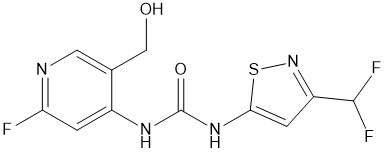BRM014 | BRM/BRG1 ATPase inhibitor

Available Options
| Size: | Price | Quantity | |
|---|---|---|---|
| 1 mg | $150.00 | ||
| 5 mg | $450.00 |
SWI/SNF-related, matrix-associated, actin-dependent regulator of chromatin subfamily A member 2 (SMARCA2), also known as Brahma homologue (BRM), together with its close homologue Brahma-related gene 1 (BRG1), or SMARCA4, are ATPases of the large ATP-dependent SWI/SNF chromatin-remodeling complexes involved in transcriptional regulation of gene expression. BRM014 (2270879-17-7) is an allosteric dual inhibitor of BRM and BRG1 (IC50<5 nM for both).1 It downregulated BRM-dependent gene expression and displayed antiproliferative activity in a BRG1-mutant-lung-tumor xenograft model after oral administration. Inhibition of BRG1/BRM ATPase by BRM014 inhibits chromatin openness.2 For example, it reduced DNA accessibility to core regulatory factors (RUNX1, LM01 and MEIS1) at transcription factor PU.1 sites in AML cells.3 P583 cells formed markedly large spheroids when treated with BRM014.4 Cell permeable and active in vivo.
References/Citations:
- Papillon et al. (2018) Discovery of orally active inhibitors of brahma homolog (BRM)/SMARCA2 ATPase activity for the treatment of brahma related gene 1 (BRG1)/SMARCA4-mutant cancers; J. Med. Chem. 61 10155
- Hargreaves et al. (2021) Chromatin openness requires continuous SW1/SNF activity; Nat. Genet. 53 263
- Chambers et al. (2023) SW1/SNF Blockade Disrupts PU.1-Directed Enhancer Programs in Normal Hematopoietic Cells and Acute Myeloid Leukemia; Cancer Res. 83 983
- Krieg et al. (2023) Chemical inhibition of SWI/SNF induces transformed growth in non-mutant cells, mimicking the effects of a SMARC4 mutation associated with small cell carcinoma of the ovary, hypercalcemic type; Gynecol. Oncol. Rep. 48 Suppl 1 S32
C11H9F3N4O2S
>98% by HPLC
NMR: (Conforms)
Safety Data Sheet:
Product Data Sheet:
Materials provided by Focus Biomolecules are for laboratory research use only and are not intended for human or veterinary applications. Please note that we do not sell to individuals and that all orders placed by non-research organizations will incur a $20 restocking/refund fee
SWI/SNF-related, matrix-associated, actin-dependent regulator of chromatin subfamily A member 2 (SMARCA2), also known as Brahma homologue (BRM), together with its close homologue Brahma-related gene 1 (BRG1), or SMARCA4, are ATPases of the large ATP-dependent SWI/SNF chromatin-remodeling complexes involved in transcriptional regulation of gene expression. BRM014 (2270879-17-7) is an allosteric dual inhibitor of BRM and BRG1 (IC50<5 nM for both).1 It downregulated BRM-dependent gene expression and displayed antiproliferative activity in a BRG1-mutant-lung-tumor xenograft model after oral administration. Inhibition of BRG1/BRM ATPase by BRM014 inhibits chromatin openness.2 For example, it reduced DNA accessibility to core regulatory factors (RUNX1, LM01 and MEIS1) at transcription factor PU.1 sites in AML cells.3 P583 cells formed markedly large spheroids when treated with BRM014.4 Cell permeable and active in vivo.
References/Citations:
- Papillon et al. (2018) Discovery of orally active inhibitors of brahma homolog (BRM)/SMARCA2 ATPase activity for the treatment of brahma related gene 1 (BRG1)/SMARCA4-mutant cancers; J. Med. Chem. 61 10155
- Hargreaves et al. (2021) Chromatin openness requires continuous SW1/SNF activity; Nat. Genet. 53 263
- Chambers et al. (2023) SW1/SNF Blockade Disrupts PU.1-Directed Enhancer Programs in Normal Hematopoietic Cells and Acute Myeloid Leukemia; Cancer Res. 83 983
- Krieg et al. (2023) Chemical inhibition of SWI/SNF induces transformed growth in non-mutant cells, mimicking the effects of a SMARC4 mutation associated with small cell carcinoma of the ovary, hypercalcemic type; Gynecol. Oncol. Rep. 48 Suppl 1 S32
Calculate the molar concentration, mass or volume in a solution.
Concentration × Volume × Molecular Weight = Mass
Focus Biomolecules • Plymouth Meeting, PA USA • 1-855-FOCUS21
Focus Biomolecules
Plymouth Meeting, PA USA
1-855-FOCUS21
Website Created by Advanta Advertising LLC.

